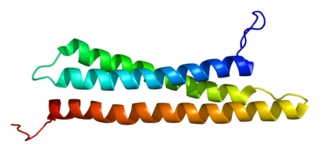
Heřmanský–Pudlák syndrome is an extremely rare autosomal recessive disorder which results in oculocutaneous albinism, bleeding problems due to a platelet abnormality, and storage of an abnormal fat-protein compound. It is considered to affect around 1 in 500,000 people worldwide, with a significantly higher occurrence in Puerto Ricans, with a prevalence of 1 in 1800. Many of the clinical research studies on the disease have been conducted in Puerto Rico.

Dysbindin, short for dystrobrevin-binding protein 1, is a protein constituent of the dystrophin-associated protein complex (DPC) of skeletal muscle cells. It is also a part of BLOC-1, or biogenesis of lysosome-related organelles complex 1. Dysbindin was discovered by the research group of Derek Blake via yeast two-hybrid screening for binding partners of α-dystrobrevin. In addition, dysbindin is found in neural tissue of the brain, particularly in axon bundles and especially in certain axon terminals, notably mossy fiber synaptic terminals in the cerebellum and hippocampus. In humans, dysbindin is encoded by the DTNBP1 gene.
BLOC-1 or biogenesis of lysosome-related organelles complex 1 is a ubiquitously expressed multisubunit protein complex in a group of complexes that also includes BLOC-2 and BLOC-3. BLOC-1 is required for normal biogenesis of specialized organelles of the endosomal-lysosomal system, such as melanosomes and platelet dense granules. These organelles are called LROs which are apparent in specific cell-types, such as melanocytes. The importance of BLOC-1 in membrane trafficking appears to extend beyond such LROs, as it has demonstrated roles in normal protein-sorting, normal membrane biogenesis, as well as vesicular trafficking. Thus, BLOC-1 is multi-purposed, with adaptable function depending on both organism and cell-type.

AP-3 complex subunit beta-1 is a protein that in humans is encoded by the AP3B1 gene.

SNARE-associated protein Snapin is a protein that in humans is encoded by the SNAPIN gene.

Syntaxin-12 is a protein that in humans is encoded by the STX12 gene.

Pallidin is a protein that in humans is encoded by the PLDN gene.

Hermansky–Pudlak syndrome 1 protein is a protein that in humans is encoded by the HPS1 gene.

AP-3 complex subunit mu-1 is a protein that in humans is encoded by the AP3M1 gene.

Hermansky–Pudlak syndrome 4 protein is a protein that in humans is encoded by the HPS4 gene.

AP-3 complex subunit sigma-2 is a protein that in humans is encoded by the AP3S2 gene.

Hermansky–Pudlak syndrome 3 protein is a protein that in humans is encoded by the HPS3 gene.

Hermansky–Pudlak syndrome 5 protein is a protein that in humans is encoded by the HPS5 gene.

Branched chain ketoacid dehydrogenase kinase (BCKDK) is an enzyme encoded by the BCKDK gene on chromosome 16. This enzyme is part of the mitochondrial protein kinases family and it is a regulator of the valine, leucine, and isoleucine catabolic pathways. BCKDK is found in the mitochondrial matrix and the prevalence of it depends on the type of cell. Liver cells tend to have the lowest concentration of BCKDK, whereas skeletal muscle cells have the highest amount. Abnormal activity of this enzyme often leads to diseases such as maple syrup urine disease and cachexia.

Biogenesis of lysosome-related organelles complex 1 subunit 2 is a protein that in humans is encoded by the BLOC1S2 gene.

Biogenesis of lysosome-related organelles complex 1 subunit 1 is a protein that in humans is encoded by the BLOC1S1 gene.

Protein cappuccino homolog is a protein that in humans is encoded by the CNO gene.

Hermansky–Pudlak syndrome 6 (HPS6), also known as ruby-eye protein homolog (Ru), is a protein that in humans is encoded by the HPS6 gene.

Dystrobrevin beta is a protein which in humans is encoded by the DTNB gene.
BLOC-3 or biogenesis of lysosome-related organelles complex 3 is a ubiquitously expressed multisubunit protein complex.

















